“I was strongly encouraged by a science teacher who took an interest in me and presented me with a key to the laboratory to allow me to work whenever I wanted.” -Frederick Reines, discoverer of the first neutrino
That kind of education is irreplaceable, and at Starts With A Bang we do our best to bring the stories, knowledge and wonder of the Universe to everyone. Here's a look back at what we hit on this past week:
- Have we solved the black hole information paradox? (for Ask Ethan),
- The ultimate superhero cake (for our Weekend Diversion),
- See inside the swirling storms of Saturn (for Mostly Mute Monday),
- How do we know the Universe is expanding evenly?, (an Astroquizzical by Jillian Scudder),
- The last great prediction of the Big Bang,
- and Pakistan's first female astrophysics Ph.D. (for Throwback Thursday).
And if you want to spot those cosmic liars, check my latest over at Forbes:
Our advance book chapter rewards have gone out to our Patreon supporters, and we're only $75 away from me creating monthly podcasts for the world. Let's make it happen and kick off the new academic year right. That said, let's take a trip into our Comments of the Week!
From Ragtag Media on black hole decay: "Why is there a caveat for light in regards to nothing escapes a black hole?"
There's no caveat here; any quantum of light that falls in past the event horizon of a black hole will not only never escape, it will in short order find its way towards the singularity at the center. The only thing escaping from a black hole is due to thermal radiation emitted from just outside the black hole's event horizon.
This is how black holes decay, but the photons that wind up getting emitted not only don't come from inside the black hole, but they have nothing to do with anything that falls in, save for the law of conservation of energy.
From Michael Kelsey on spinning black holes: "Not all black holes have maximal spin; in fact, most probably do not. You may wish to lookup the “Kerr metric” for more detailed information on black hole spin, the difference between the event horizon (for the zero spin Schwarzchild metric) and ergosphere, and the spin upper limit."
While there is some evidence for incredibly relativistic supermassive black hole spins, the exact solution for massive, spinning black holes was provided by Roy Kerr only in 1963. This is all the more incredible when you realize that Karl Schwarzschild provided the solution to a massive, spinning black hole just a month after Einstein published his relativity theory in 1915.
So for a spinning black hole, you have two components to it: mass and angular momentum. Despite your eagerness to have a black hole where most of the "hair" on it is due to its spin, there's an upper limit to that of just 18-19% of the total hair; mass must be the rest. Even if you start it off with more, it's an unstable configuration and will spin down until it's below that limit, radiating that extra angular momentum away. What's perhaps most interesting is that unlike a Schwarzschild black hole, which has a point singularity at the center, a Kerr black hole, due to its spin, has its singularity stretched out into a ring. Even though any infalling object will eventually slam into that one-dimensional (not zero-dimensional) singularity, it is possible to pass through the ring at least once before doing so. Isn't that something?!
Image credit: Powermaster Optimus Prime, via http://www.angelfire.com/scifi/bbfortress/pmprime.html.
From Wow on the Transformers: "Transformers hasn’t survived 30 years of moving on, however. At least not the first series. Which consisted of “Autobots get asses kicked by Deceptecons without Optimus Prime. Optimus Prime turns up, does a John Wayne and kicks the ass of every Decepticon. End”."
To each their own, although I have to say I've given three of my childhood favorite shows -- Transformers, Thundercats and He-Man -- a shot as an adult. Transformers held up the best for me, as Optimus Prime wasn't the lone hero like John Wayne (or, perhaps more aptly, Gary Cooper in High Noon), but was rather the tide-turner who made everyone better when he was around. (That's how he dies in the movie, after all.) On the other hand, He-Man's plot lines are laughable (Skeletor concocts a clever plan, foils He-Man and his allies, but then -- surprise! -- He-Man is stronger than you expected, and wins), and the Thundercats... well, how much patience do you have? The dialogue is painfully slow, and punctuated by exchanges like, "Use your sword, Lion-o!" "Right!"
On the other hand, I wholeheartedly agree with Denier...
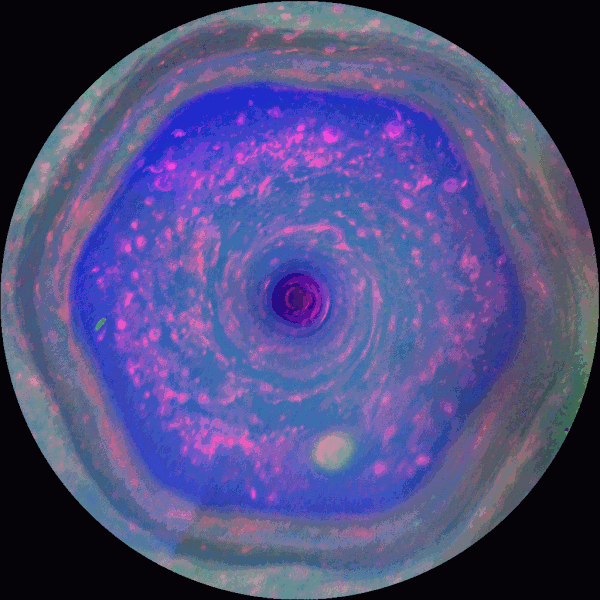 Image credit: NASA/JPL-Caltech/SSI/Hampton University, via http://www.jpl.nasa.gov/spaceimages/details.php?id=PIA17652, of Saturn’s north polar storm in false color.
Image credit: NASA/JPL-Caltech/SSI/Hampton University, via http://www.jpl.nasa.gov/spaceimages/details.php?id=PIA17652, of Saturn’s north polar storm in false color.
Here's a fun one from Denier on Saturn's polar storm: "The hexagonal polar storm is curious. It only seems to appear on one pole. A hexagonal polar storm has also been seen on Neptune, which means they’re probably common on gas giants."
Well, perhaps. Saturn's north pole has a hexagonal pattern -- which can be modeled as a feature of its jet stream -- but its south pole doesn't have one. Neptune may have one on its south pole, but the Voyager image you refer to, reprocessed by Rolf Olsen? It's... suggestive, to be sure. But convincing?
I need better evidence to be convinced of that. They may be somewhat common, but I want a larger sample size... and I also want to be sure that this isn't a transient feature on Neptune first!
Okay, but that said, there are a wide range of simulation parameters that produce hexagons in the laboratory.
Healthy skepticism aside, Denier, you're probably right. These patterns are likely common on gas giant worlds. Whether that means 10%, 25% or 75% of them have it remains to be seen, but I would be quite surprised if it were under 10%.
From Pavel on the expanding Universe: "I do not agree with the sentence: “With every measurement that was taken of these spiral and elliptical “nebulae” in the skies, it became clear that each one appeared to be moving away from us.”
Actually, what has Hubble [measured] is that the galaxies _in [average]_ are red-shifted, but there were also blue-shifted galaxies. E.g. the Andromeda galaxy is moving toward us.
This average red shift was the basis for the conclusion that the Universe was expanding. If it were static, the average frequency shift would be zero.
Of course, Hubble [measured] only the nearest galaxies. Galaxies that are far enough are actually all red-shifted."
This brings up a very good point about what we measure when we measure the motion of any galaxy. For example, the picture below shows two galaxies near the heart of the Virgo Cluster: M84 and M86. They're both giant ellipticals, they're both about 50-60,000,000 light years away, and they're extremely close to one another in the Universe.
But M84 recedes from us at around 900 km/s, while M86 approaches us at some 400 km/s! This is because there are two effects that add up to a galaxy's apparent redshift:
- The Hubble (cosmic) expansion of the Universe, which affects all objects that exist in our Universe's spacetime, and appears more impactful the farther a galaxy is.
- Each galaxy's peculiar velocity, or how much local gravitational effects cause it to move relative to the CMB's rest frame in the Universe.
That second effect is typically hundreds or even up to the low thousands of km/s, but that first effect is entirely distance-dependent. In other words, if the Hubble rate is 68 km/s/Mpc, then objects need to be about 40 Mpc away before the effects of a cosmic redshift always defeat the peculiar velocity effects. The Virgo cluster, for example, is only about 14-17 Mpc away, so that's no good. But all the galaxies of the Coma cluster should have a redshift to them. So that's why we see what we see, but why the redshift always wins at large enough distances.
From MandoZink on the Universe beyond our perception: "What are the estimates for how much universe may exist beyond the Hubble Sphere, and how are those estimates determined?"
I wrote about this almost two years ago, and there is one assumption that we make: that the Universe is topologically the way it appears to be. In other words, that so long as we don't see evidence that the Universe closes in on itself for the part we see -- that it doesn't appear to "repeat" in some location or have the same galaxy at point A and point B -- that it doesn't close on itself unless it's in a fashion described by its spatial curvature.
And so what we measure is the limits on that spatial curvature, or the possible departure from perfect flatness, of the observable Universe on the largest scales. We get this from Baryon Acoustic Oscillation measurements, as well as Cosmic Microwave Background data. The combination of these two allow us to determine -- as of early 2015 -- that spatial curvature is at most 0.25% of perfect flatness, meaning that the unobservable Universe is at least ~400 times as large as the part we observe.
Image credit: ©2012-2015 janbeziparkem of deviantART, via http://janbeziparkem.deviantart.com/art/Fritz-Zwicky-315642752.
From Ragtag Media on the most iconoclastic astrophysicist of the 20th century: "What Would Fritz Zwicky Say?"
To quote from Wikipedia:
Zwicky described his colleagues “scatterbrains,” “sycophants and plain thieves” who “have no love for any of the lone wolves who are not fawners and apple polishers,” who “doctor their observational data to hide their shortcomings and to make the majority of the astronomers accept and believe in some of their most prejudicial and erroneous presentations and interpretations of facts,” and who therefore publish “useless trash in the bulging astronomical journals.”
I am sure he would say something along those lines.
 Image credit: Brent Follin, Lloyd Knox, Marius Millea, and Zhen PanPhys. Rev. Lett. 115, 091301 — Published 26 August 2015.
Image credit: Brent Follin, Lloyd Knox, Marius Millea, and Zhen PanPhys. Rev. Lett. 115, 091301 — Published 26 August 2015.
And finally, from PJ on the discovery of the cosmic neutrino background: "No holding back on good science!
Bravo."
What many of you don't know is that some years ago -- in 2005, I think -- I had the pleasure of meeting Lloyd Knox, one of the authors of this paper, at a summer school/conference. I asked him if I could write about this paper, and he was excited for it. He communicated some extra things to me privately which, with his permission, I'm happy to share with you.
I would say that, already, if we assume 3 neutrino species, we have a good constraint on the temperature of the neutrino background -- the constraint on Neff can be translated into a constraint on temperature. Since fractional error in Neff is about 0.07 (=0.2/3), and Neff scales as T^4, we already know the CNB temperature with a fractional uncertainty of 0.07/4, or less than 2%! [This is already using polarization data, the error of 0.2 on Neff.] We don't have a way to estimate the temperature without assuming the number of species.
Neff, by the way, is the number of effective neutrino species, which is determined by certain temperature properties of the cosmic microwave background and its fluctuations. That electron-positron annihilation injects a certain amount of energy back into the photon species, energy that would be distributed differently if there were more (or fewer) neutrino species. So what we're seeing already agrees with the standard prediction... and the Planck polarization spectra should only confirm it to unprecedented accuracy. Can't wait!
Thanks for a great week, everyone, and looking forward to whatever next week has in store!
- Log in to post comments

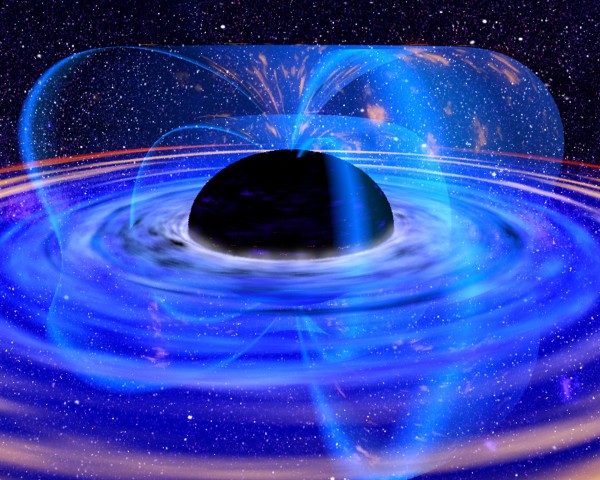
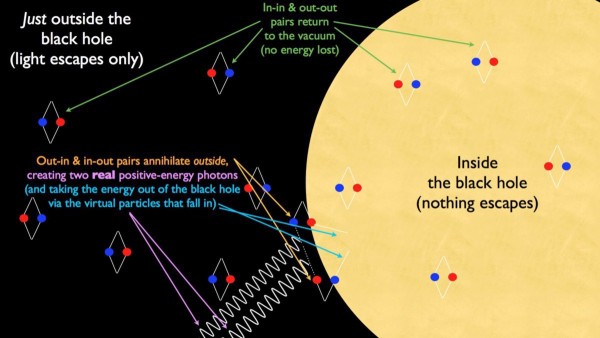
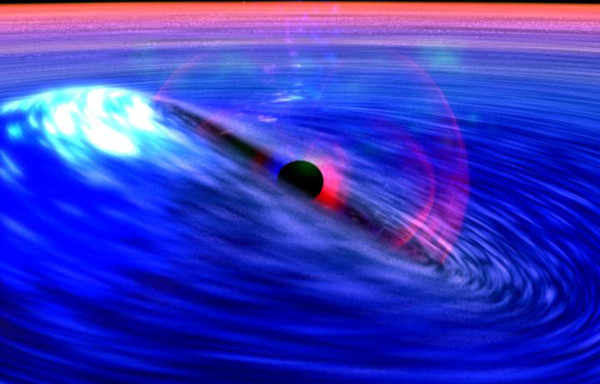
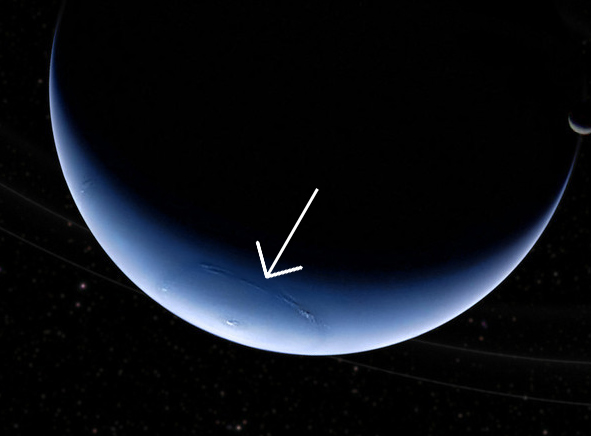
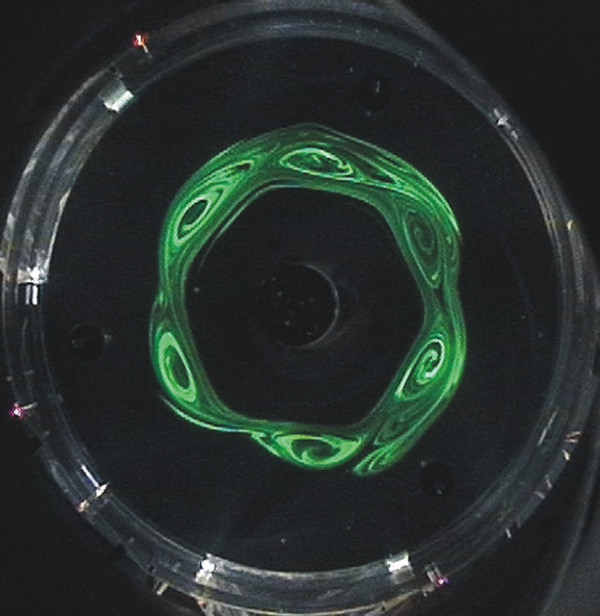
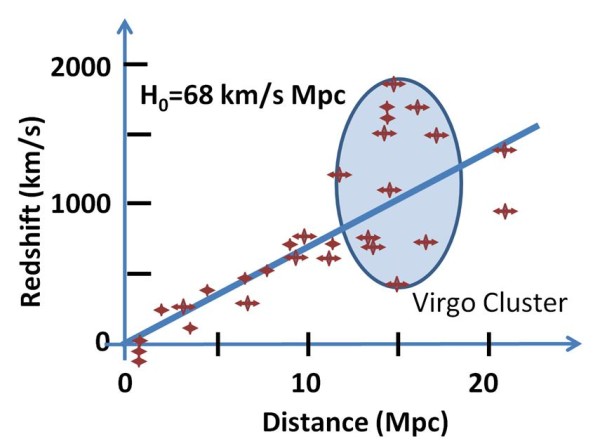
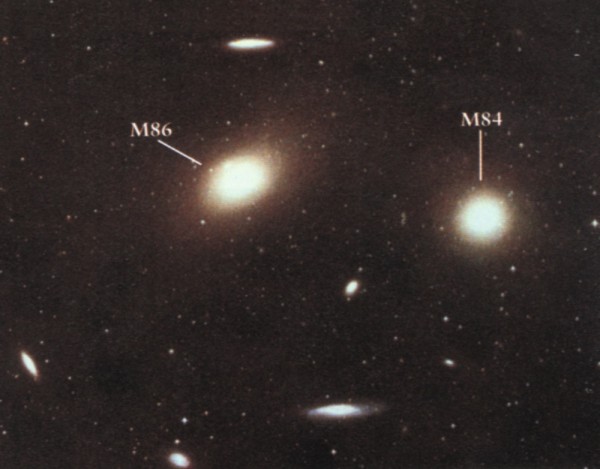
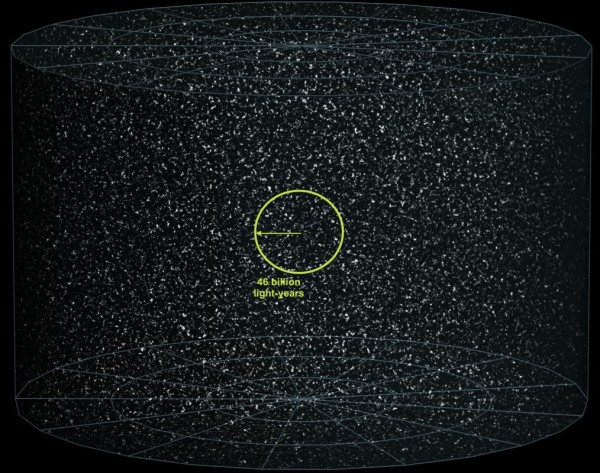
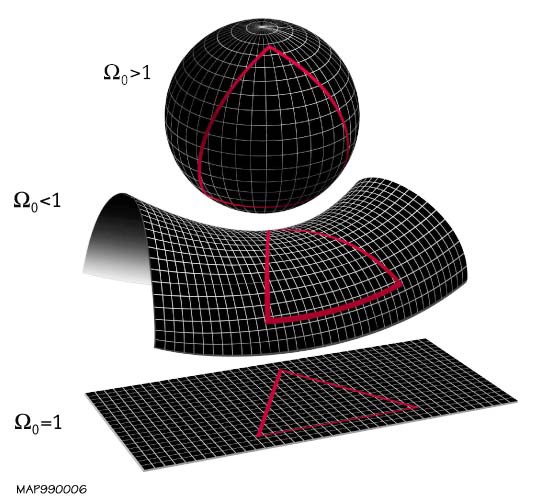
How fast (i.e, what value of gamma) would a relativistic spacecraft have to be traveling for the cosmic neutrino background to be dangerous to its passengers?
in the section about redshift and the virgo cluster:
"they’re both about 50-60,000 light years away"
you skipped a few zero's there i believe...
Neutrinos react via the weak force and they can therefore travel through light years of lead. A galaxy of stars. Your pasty white body won't cause any significant obstacle to its passage.
And if it doesn't interact, it can't cause damage.
So your question would depend on what dump of a single event's energy would cause some catastrophic damage in the occasion it happens.
Not really an easy question to answer, since macro scale energy is easily handled even at massive particle energies.
You're thinking of charged particles and photons, I think.
They cause damage by breaking chemical bonds and causing biological damage that way. To break a chemical bond you need to interact via the electromagnetic interaction. The uncharged particles don't do that.
The other way is to kick the atom so hard that it either decays (producing charged particles that cause the damage above) or hurl the atom out of the chemical bond and thereby cause the damage above. That requires a nuclear interaction, which means the neutron.
A 1MeV particle. That needs a few MeV to be a problem, and a huge number of interactions (see Sievert) to be dangerous.
So the neutrinos need several MeV from relativistic speeds to do the same thing as neutrons do.
But they interact so poorly that they have to be available in MASSIVE numbers to cause the same damage to your body.
So it isn't the energy of the neutrino (several MeV), but the flux. And going fast and shifting their energies up doesn't inccrease the flux much...
Wow is whining again...
@Brian #4: I think you posted this to the wrong thread :-/ Wow's comment here isn't whining; it's a legitimate response to Paul D's question about what the CNB might look like to a relativistic ship.
Remember that some people don't really care about what's written, all that matters is who said it.
And they, like children, hear grown ups using words and repeat them under the idea that it must be an adult thing to do.
Discover the fascinating relation between time and the cosmos. Enjoy this interactive learning tool and understand the concept of the celestial sphere and the apparent movement of the sky. https://play.google.com/store/apps/details?id=com.cosmic_watch.cosmicwa…